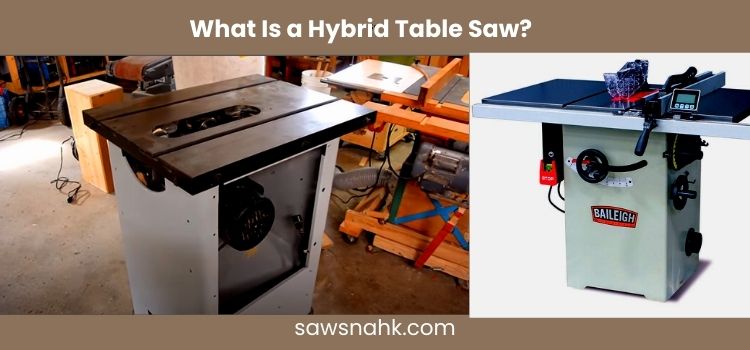What Is a Hybrid Table Saw? Ultimate Guide

Have you ever wondered what a Hybrid Table Saw is and how it differs from other types of Table Saw? A Hybrid Table Saw combines a Contractor Saw, and a Cabinet Saw, offering the best of both worlds for woodworkers and DIY enthusiasts. But what exactly makes a Hybrid Table Saw unique, and is it the right choice for your workshop? Read on to find out!
The first that comes to mind when someone mentions a “Hybrid Table Saw” is the Saw used by carpenters. But there’s much more to a Hybrid Table Saw than meets the eye. The truth is that Hybrid Table Saws aren’t just for carpenters anymore. The market for these Saws has exploded in recent years, and now anyone can use one to get the job done.
Main Components of a Hybrid Table Saw
Hybrid Table Saws have the following components:
Tabletop:
The tabletop is where the material to be cut is placed. It is typically made of cast iron or steel and is flat and level to ensure accurate cuts.
Blade:
The blade is the cutting tool of the Saw. It is typically made of steel or carbide and comes in various sizes and tooth configurations.
Arbor:
The arbor is the shaft that the blade is mounted on. It is driven by an electric motor to rotate the blade at high speeds.
Electric Motor:
The electric motor provides the power to rotate the blade. It is typically located beneath the tabletop and is connected to the arbor by a belt or direct drive mechanism.
HOW DO Hybrid Table Saws WORK?
Hybrid Table Saws are a type of Saw that combines features from both Contractor Saws and Cabinet Saws. They typically feature a solid, heavy-duty base as a Cabinet Saw but with a smaller and more portable size as a Contractor Saw.
In terms of operation, a Hybrid Table Saw works by spinning a circular blade around an arbor (a shaft that the blade rotates on) to make cuts in a workpiece. The workpiece is usually placed against a flat table, mounted on top of the Saw’s base, and guided through the blade using a fence or other guidance system.
The blade of a Hybrid Table Saw can be raised or lowered to adjust its depth of cut and tilted to make angled cuts. The speed of the blade is usually controlled by a motor, which can be adjusted to match the material being cut.
One of the key advantages of a Hybrid Table Saw is its versatility. It can be used for various tasks, including ripping long boards, cross-cutting short pieces, and making bevel cuts.
Advantages Of Hybrid Table Saw
A Hybrid Table Saw has the following advantages:
Lighter weight:
Hybrid Table Saws are typically weightier than traditional Cabinet Saws, making them easier to move and set up in a workshop. This makes them popular for hobbyists and DIY enthusiasts who may need a dedicated space for a larger Saw.
Improved cutting technique:
Hybrid Table Saws combine Contractor, and Cabinet Table Saw features, providing a mix of affordability, versatility, and power. This results in improved cutting accuracy and versatility compared to other saws.
Less power needed:
Hybrid Table Saws typically use a lighter and more efficient induction motor with less power than traditional cabinet saws with a heavy and power-hungry universal motor. This results in lower energy consumption and operating costs.
Smaller in size:
Hybrid Table Saws are smaller than traditional Cabinet Saws, making them a more space-saving option for those with limited workshop space. This makes them more portable and easier to move around if needed. Their compact size makes them easier to store when not in use.
Lower price:
Hybrid Table Saws often cost less than traditional models, making them a more affordable option for budget-conscious consumers. This can be especially beneficial for those just starting with woodworking who want to invest less money in their tools.
Features of a Hybrid Table Saw:
Some features of the Hybrid Table Saw are discussed below:
Design and Size:
A Hybrid Table Saw usually combines Cabinet and Contractor Saw features. It has a cabinet base for stability and a closed stand for dust containment, with a lighter weight and more compact size than a full-sized Cabinet Saw.
The Hybrid Table Saw typically has a smaller tabletop and less extensive fence system than a Cabinet Saw. The Hybrid Table Saw’s size and design make it suitable for workshops with limited space.
Dust Collection:
Hybrid Table Saw has built-in dust collection systems, typically with a 4-inch dust port, often connected to a shop vacuum. This helps keep the workspace clean and prevents sawdust buildup on the Saw or in the air. The dust collection system also helps maintain the Saw’s longevity and performance.
Weight and Portability:
Hybrid Table Saws are lighter than Cabinet Saws and usually weigh around 100 to 150 pounds, making them easier to move around the workshop or transport to job sites. Some models come with wheels or a built-in handle for improved portability.
Safety Features:
Hybrid Table Saws typically have several safety features to protect the user, including blade guards, anti-kickback pawls, riving knives, and blade-braking systems. These features help reduce the risk of injury and accidents while using the Saw. Some Hybrid Table Saw also have magnetic switches, which shut off the Saw automatically in case of a power outage or other emergency.
Adjustable Blade Height:
A feature of a Hybrid Table Saw is the ability to adjust the blade height, allowing the user to change the cutting depth to accommodate different materials and thicknesses. This feature provides versatility and flexibility in cutting and can be useful for various tasks and projects.
Adjustable Fence:
An adjustable fence is a feature of a Hybrid Table Saw that allows the user to adjust the position of the fence relative to the blade, which can help improve the accuracy and precision of cuts. This feature can also be useful for cutting wider or thicker materials that may not fit through the saw blade without adjusting the fence.
Conclusion!
In conclusion, what is a Hybrid Table Saw? Hybrid Table Saws balance size, weight, and features for a compact, portable, and versatile saw for home and professional use. With built-in safety and dust collection features, hybrid Table Saws are a convenient and safe choice for woodworkers of all skill levels.
FAQs.
What makes a Tablesaw a Hybrid?
A Table Saw is considered a Hybrid because it typically combines the functionality of a Contractor Saw with the durability and precision of a Cabinet Saw.
What is the difference between a Skill Saw and a Table Saw?
The difference between a Skill Saw and a Table Saw is that a Skill Saw is a type of handheld circular saw typically used for making rough cuts. In contrast, a Table Saw is a Stationary Saw mounted on a table and used for precise cuts.
What’s the difference between a Table Saw and a Cabinet Saw?
The main difference between a Table and Cabinet Saw is its size and weight. Cabinet Saws are larger and more heavy-duty, making them ideal for professional woodworkers and cabinet makers. Table Saws are more compact and portable, making them a good choice for home woodworkers and DIY projects.
